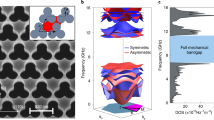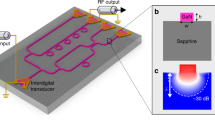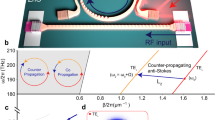Abstract
Optomechanics, nano-electromechanics, and integrated photonics have brought about a renaissance in phononic device physics and technology. Central to this advance are devices and materials supporting ultra-long-lived photonic and phononic excitations that enable novel regimes of classical and quantum dynamics based on tailorable photon–phonon coupling. Silica-based devices have been at the forefront of such innovations for their ability to support optical excitations persisting for nearly 1 billion cycles, and for their low optical nonlinearity. While acoustic phonon modes can persist for a similar number of cycles in crystalline solids at cryogenic temperatures, it has not been possible to achieve such performance in silica, as silica becomes acoustically opaque at low temperatures. We demonstrate that these intrinsic forms of phonon dissipation are greatly reduced (by >90%) by nonlinear saturation using continuous drive fields of disparate frequencies. The result is a form of steady-state phononic spectral hole burning that produces a wideband transparency window with optically generated phonon fields of modest (nW) powers. We developed a simple model that explains both dissipative and dispersive changes produced by phononic saturation. Our studies, conducted in a microscale device, represent an important step towards engineerable phonon dynamics on demand and the use of glasses as low-loss phononic media.
This is a preview of subscription content, access via your institution
Access options
Subscribe to this journal
Receive 12 print issues and online access
$259.00 per year
only $21.58 per issue
Buy this article
- Purchase on Springer Link
- Instant access to full article PDF
Prices may be subject to local taxes which are calculated during checkout





Similar content being viewed by others
References
Kippenberg, T. J. & Vahala, K. J. Cavity optomechanics: back-action at the mesoscale. Science 321, 1172–1176 (2008).
Bochmann, J., Vainsencher, A., Awschalom, D. D. & Cleland, A. N. Nanomechanical coupling between microwave and optical photons. Nat. Phys. 9, 712–716 (2013).
Lee, H. et al. Chemically etched ultrahigh-Q wedge-resonator on a silicon chip. Nat. Photon. 6, 369–373 (2012).
Meenehan, S. M. et al. Pulsed excitation dynamics of an optomechanical crystal resonator near its quantum ground state of motion. Phys. Rev. X 5, 041002 (2015).
Goryachev, M., Creedon, D. L., Galliou, S. & Tobar, M. E. Observation of Rayleigh phonon scattering through excitation of extremely high overtones in low-loss cryogenic acoustic cavities for hybrid quantum systems. Phys. Rev. Lett. 111, 085502 (2013).
Shin, H. et al. Tailorable stimulated Brillouin scattering in nanoscale silicon waveguides. Nat. Commun. 4, 1944 (2013).
Shin, H. et al. Control of coherent information via on-chip photonic–phononic emitter-receivers. Nat. Commun. 6, 6427 (2015).
Chan, J. et al. Laser cooling of a nanomechanical oscillator into its quantum ground state. Nature 478, 89–92 (2011).
Fiore, V. et al. Storing optical information as a mechanical excitation in a silica optomechanical resonator. Phys. Rev. Lett. 107, 133601 (2011).
Weis, S. et al. Optomechanically induced transparency. Science 330, 1520–1523 (2010).
Cheung, H. F. H., Patil, Y. S., Chang, L., Chakram, S. & Vengalattore, M. Nonlinear phonon interferometry at the Heisenberg limit. Preprint at http://arXiv.org/abs/1601.02324 (2016).
Regal, C. A., Teufel, J. D. & Lehnert, K. W. Measuring nanomechanical motion with a microwave cavity interferometer. Nat. Phys. 4, 555–560 (2008).
Kang, M. S., Nazarkin, A., Brenn, A. & Russell, P. S. J. Tightly trapped acoustic phonons in photonic crystal fibres as highly nonlinear artificial Raman oscillators. Nat. Phys. 5, 276–280 (2009).
Schliesser, A. et al. Optical frequency comb generation from a monolithic microresonator. Nature 450, 1214–1217 (2007).
Kippenberg, T. J., Holzwarth, R. & Diddams, S. A. Microresonator-based optical frequency combs. Science 332, 555–560 (2011).
Phillips, W. A. Two-level states in glasses. Rep. Prog. Phys. 50, 1657–1708 (1987).
Portis, A. M. Electronic structure of F centers: saturation of the electron spin resonance. Phys. Rev. 91, 1071–1078 (1953).
Szabo, A. Observation of hole burning and cross relaxation effects in ruby. Phys. Rev. B 11, 4512–4517 (1975).
Jessop, P. E., Muramoto, T. & Szabo, A. Optical hole burning in ruby. Phys. Rev. B 21, 926–936 (1980).
Basche, T. & Moerner, W. E. Optical modification of a single impurity molecule in a solid. Nature 355, 335–337 (1992).
Golding, B., Graebner, J. E., Halperin, B. I. & Schutz, R. J. Nonlinear phonon propagation in fused silica below 1 K. Phys. Rev. Lett. 30, 223–227 (1973).
Golding, B., Graebner, J. E. & Schutz, R. J. Intrinsic decay lengths of quasimonochromatic phonons in a glass below 1 K. Phys. Rev. B 14, 1660–1662 (1976).
Arnold, W., Hunklinger, S., Stein, S. & Dransfeld, K. Nonlinear ultrasonic attenuation in glasses. J. Non-Cryst. Solids 14, 192–200 (1974).
Arnold, W. & Hunklinger, S. Experimental evidence for the direct interaction between two-level systems in glasses at very low temperatures. Solid State Commun. 17, 883–886 (1975).
Arnold, W., Martinon, C. & Hunklinger, S. Direct experimental observation of spectral diffusion in vitreous silica at low temperatures. J. Phys. Colloq. 39, C6961–C6963 (1978).
Black, J. L. & Halperin, B. I. Spectral diffusion in glasses at low temperatures. Phys. Rev. B 24, 813–816 (1977).
Behunin, R. O., Intravaia, F. & Rakich, P. T. Dimensional transformation of defect-induced noise, dissipation, and nonlinearity. Phys. Rev. B 93, 224110 (2016).
Siegman, A. E. Lasers (Univ. Science Books, 1986).
Skinner, J. L. & Moerner, W. E. Structure and dynamics in solids as probed by optical spectroscopy. J. Phys. Chem. 100, 13251–13262 (1996).
Jankowiak, R. & Small, G. J. Hole-burning spectroscopy and relaxation dynamics of amorphous solids at low temperatures. Science 237, 618–625 (1987).
Moerner, W. E. (ed.) Persistent Spectral Hole-Burning: Science and Applications (Springer, 1988).
Boyd, R. W. Nonlinear Optics 2nd edn (Academic, 2003).
Behunin, R. O. et al. Long-lived guided phonons in fiber by manipulating two-level systems. Preprint at http://arXiv.org/abs/1501.04248 (2015).
Dragic, P. D. Brillouin spectroscopy of Nd-Ge co-doped silica fibers. J. Non-Cryst. Solids 355, 403–413 (2009).
Park, Y.-S. & Wang, H. Resolved-sideband and cryogenic cooling of an optomechanical resonator. Nat. Phys. 5, 489–493 (2009).
Bahl, G., Zehnpfennig, J., Tomes, M. & Carmon, T. Stimulated optomechanical excitation of surface acoustic waves in a microdevice. Nat. Commun. 2, 403 (2011).
Bahl, G., Tomes, M., Marquardt, F. & Carmon, T. Observation of spontaneous Brillouin cooling. Nat. Phys. 8, 203–207 (2011).
Anetsberger, G., Rivière, R., Sehliesser, A., Arcizet, O. & Kippenberg, T. J. Ultralow dissipation optomechanical resonators on a chip. Nat. Photon. 2, 627–633 (2009).
Schliesser, A., Rivière, R., Anetsberger, G., Arcizet, O. & Kippenberg, T. J. Resolved-sideband laser cooling of a micromechanical oscillator. Nat. Phys. 4, 415–419 (2008).
Schliesser, A., Arcizet, O., Rivière, R., Anetsberger, G. & Kippenberg, T. J. Resolved-sideband cooling and position measurement of a micromechanical oscillator close to the Heisenberg uncertainty limit. Nat. Phys. 5, 509–514 (2009).
Rivière, R. et al. Optomechanical sideband cooling of a micromechanical oscillator close to the quantum ground state. Phys. Rev. A 83, 063835 (2011).
Okawachi, Y. et al. Tunable all-optical delays via Brillouin slow light in an optical fiber. Phys. Rev. Lett. 94, 153902 (2005).
Stokes, L. F., Chodorow, M. & Shaw, H. J. All-fiber stimulated Brillouin ring laser with submilliwatt pump threshold. Opt. Lett. 7, 509–511 (1982).
Boyd, R. W. & Gauthier, D. J. Controlling the velocity of light pulses. Science 326, 1074–1077 (2009).
Kim, J., Kuzyk, M. C., Han, K., Wang, H. & Bahl, G. Non-reciprocal Brillouin scattering induced transparency. Nat. Phys. 11, 275–280 (2015).
Vahala, K. et al. A phonon laser. Nat. Phys. 5, 682–686 (2009).
Mahboob, I., Nishiguchi, K., Fujiwara, A. & Yamaguchi, H. Phonon lasing in an electromechanical resonator. Phys. Rev. Lett. 110, 127202 (2013).
Anderson, P. W., Halperin, B. I. & Varma, C. M. Anomalous low-temperature thermal properties of glasses and spin glasses. Philos. Mag. 25, 1–9 (1972).
Acknowledgements
The authors thank P. Fleury, H. Shin, E. Kittlaus, N. Otterstrom and S. Gertler for a number of thoughtful criticisms and suggestions. Primary support for this work was provided by NSF MRSEC DMR-1119826. This work was supported in part by the Packard Fellowship for Science and Engineering as well as Yale University startup funding.
Author information
Authors and Affiliations
Contributions
R.O.B., P.K. and P.T.R. conceived, designed, and built the spectral hole burning experiments with the assistance of W.H.R. R.O.B. and P.K. performed the measurements and analysed the data with the assistance of W.H.R. and P.T.R. R.O.B. and P.T.R. developed the spectral hole burning theory with assistance from P.K. and W.H.R. All authors contributed to the writing of this paper.
Corresponding authors
Ethics declarations
Competing interests
The authors declare no competing financial interests.
Supplementary information
Supplementary Information
Supplementary Information (PDF 2000 kb)
Rights and permissions
About this article
Cite this article
Behunin, R., Kharel, P., Renninger, W. et al. Engineering dissipation with phononic spectral hole burning. Nature Mater 16, 315–321 (2017). https://doi.org/10.1038/nmat4819
Received:
Accepted:
Published:
Issue Date:
DOI: https://doi.org/10.1038/nmat4819
This article is cited by
-
A quantum memory at telecom wavelengths
Nature Physics (2020)
-
Achieving long phonon lifetimes
Nature Materials (2017)



